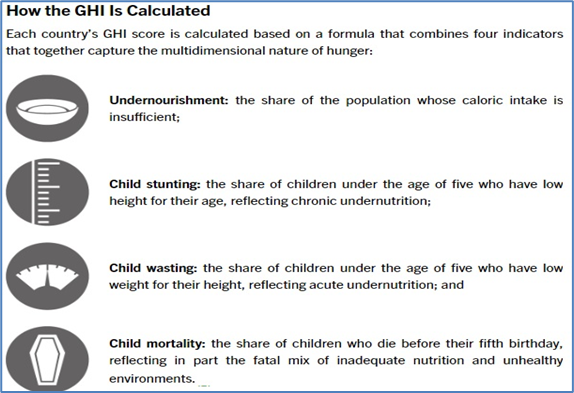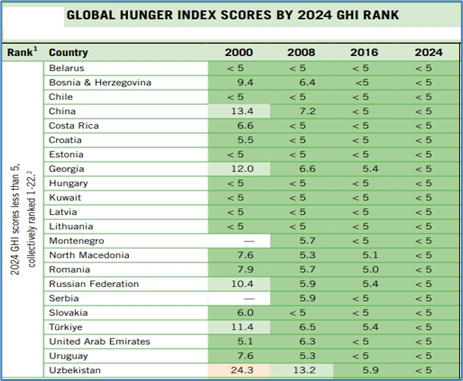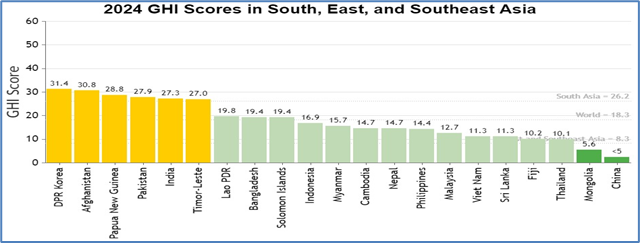Why in News?
India's struggle with hunger and malnutrition has been underscored by its ranking in the 2024 Global Hunger Index (GHI), where it stands 105th out of 127 countries with a score of 27.3, categorising it in the 'serious' range.
Despite being one of the fastest-growing economies globally, India continues to lag behind several of its South Asian neighbours, highlighting the urgent need for effective interventions.
What’s in Today’s Article?
- What is the GHI?
- Highlights of the 19th GHI 2024
- India Specific Findings in the GHI 2024
- India's Performance Trends in the GHI
- Addressing Hunger and Malnutrition in India
What is the GHI?

- The GHI is a peer-reviewed annual publication designed to comprehensively measure and track hunger at global, regional, and national levels, reflecting multiple dimensions of hunger over time.
- Created in 2006, the GHI was initially published by the US-based International Food Policy Research Institute (IFPRI) and Germany-based Welthungerhilfe. In 2007, the Irish NGO Concern Worldwide also became a co-publisher.
- In 2018, IFPRI withdrew from the project and the GHI became a joint project of Welthungerhilfe and Concern Worldwide.
- The GHI is intended to -
- Raise awareness and understanding of the struggle against hunger,
- Provide a way to compare levels of hunger between countries and regions, and
- Call attention to those areas of the world where hunger levels are highest and where the need for additional efforts to eliminate hunger is greatest.
Highlights of the 19th GHI 2024:

- Theme: The theme for the 2024 Global Hunger Index (GHI) is "How gender justice can advance climate resilience and zero hunger".
- Global hunger statistics:
- Current GHI score: 8.3 shows a slight improvement from 2016's score of 18.8.
- Vulnerable populations: 2.8 billion people cannot afford a healthy diet.
- Regional disparities in hunger:
- Sub-Saharan Africa: Highest rates of malnutrition and child mortality globally and ongoing conflicts in Somalia and Sudan exacerbate hunger crises.
- South Asia: Countries like Afghanistan, India, and Pakistan are facing substantial hunger challenges.
- Issues:
- Difficulties in achieving SDG 2 (Zero Hunger by 2030): The GHI 2024 reveals that 42 countries face alarming or serious hunger levels, marking a stagnation in the fight against hunger despite decades of progress.
- Gender disparity: Women are particularly vulnerable to food insecurity due to discriminatory norms and violence, limiting their access to resources.
- Underlying causes of hunger:
- Climate change and environmental degradation impacts food production and threatens the natural foundations of economies and agriculture.
- Armed conflicts lead to significant displacement and disruption in food systems and affect cultivation.
- Lower-income countries struggle with debt, diverting funds away from critical development needs.
- Success stories amidst the crisis: Countries like Mozambique and Nepal have achieved significant improvements in their GHI scores since 2016, showcasing that progress is possible.
- A call to action:
- The GHI 2024 underscores the urgent need for coordinated efforts to address the intersecting crises of climate change, armed conflict, gender inequality and economic instability.
- It emphasises the importance of supporting vulnerable populations, particularly women, in the fight against hunger.
India Specific Findings in the GHI 2024:
- Alarming child malnutrition rates:
- Approximately 35.5% of children under five are stunted, indicating chronic undernutrition, while 18.7% are wasted, a sign of acute malnutrition.
- These figures reflect a significant lack of adequate nutrition during crucial developmental periods, severely impacting children's physical and cognitive growth.
- Furthermore, around 13.7% of the overall population suffers from undernourishment, which remains a persistent issue.
- Child mortality rates:
- While there has been some progress in reducing child mortality, with 2.9% of children dying before their fifth birthday, the overall hunger situation remains dire.
- The interplay between malnutrition and child mortality underscores the need for immediate action.
India's Performance Trends in the GHI:
- Minimal improvement over the decade:
- There is a stagnation in India’s performance as it moved from a score of 29.3 in 2016 to 27.3 in 2024.
- Although there have been gains in certain areas, such as child mortality rates, the overarching issue of hunger persists.
- India vs. neighbours:

- When compared to neighbouring countries like Sri Lanka, Nepal, and Bangladesh - each of which has fewer economic resources - India's performance on the GHI is particularly alarming.
- This indicates that economic growth alone does not necessarily lead to improved nutritional outcomes.
Addressing Hunger and Malnutrition in India:
- The need for comprehensive solutions:
- India's GHI score serves as a stark reminder that economic advancement is insufficient for eradicating hunger.
- A more holistic approach is required to tackle the underlying causes of malnutrition.
- Effective policy interventions including key focus areas such as:
- Food security: Ensuring access to nutritious food for all segments of the population is essential.
- Healthcare access: Improving healthcare infrastructure can significantly impact maternal and child health outcomes.
- Maternal and child nutrition programs: Investing in targeted nutritional programs for mothers and children is vital for breaking the cycle of malnutrition.
- Some initiatives in India: National Food Security Act (NFSA), PM POSHAN Scheme, etc.










